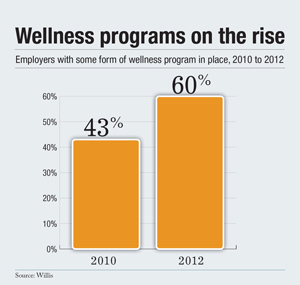 More employers than ever are embracing wellness programs, finds a Willis report.
More employers than ever are embracing wellness programs, finds a Willis report.
Sixty percent of the 1,600 employers surveyed by Willis said they have some form of wellness program in place, up from 43 percent in 2010. And the majority of businesses with programs in place are looking to expand and invest in them.
"Wellness programs continue to evolve and it is encouraging to see more organizations initiate programs despite economic pressures and continuing challenges in accurately measuring outcomes and results," says Jennifer Price, senior health outcomes consultant at Willis.
Recommended For You
But employers are struggling with how to get employees to participate and stay engaged. About 76 percent of companies say increasing participation is the top goal for their wellness program in the next year.
Also, almost half of employers said the leading barrier to measuring success was difficulty in determining the influence of wellness compared with other factors impacting health care costs. Insufficient data and not enough staffing/time remain common barriers to measuring success, research finds.
The most common types of wellness programs being offered include physical activity programs (53 percent), tobacco cessation programs (49 percent) and weight management programs (45 percent).
More than half of employers are said they are promoting work/life balance programs within their worksite wellness program. After employee assistance programs, flexible start/end times (at 81 percent) are the most common offering of these balance program options. The survey also found helping employees achieve work/life balance is "a significant concern" by 18 percent of respondents, and somewhat of a concern by 54 percent.
© Touchpoint Markets, All Rights Reserved. Request academic re-use from www.copyright.com. All other uses, submit a request to [email protected]. For more inforrmation visit Asset & Logo Licensing.






